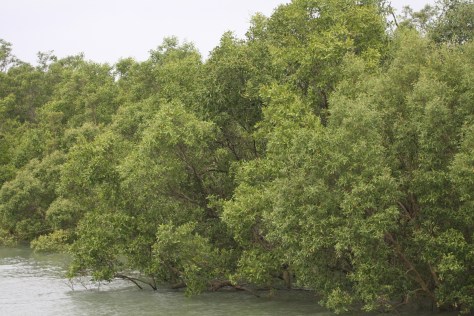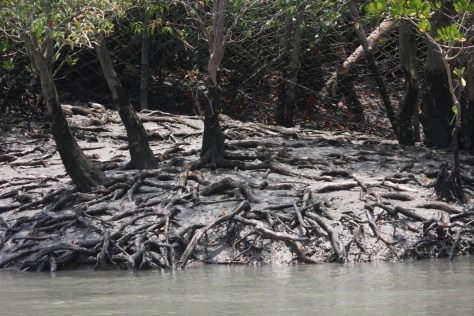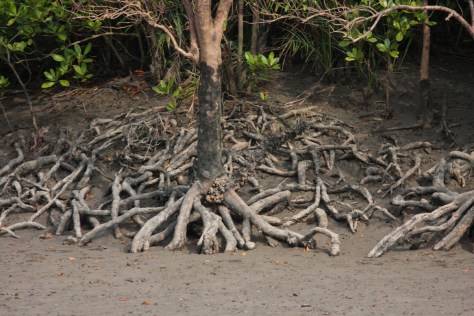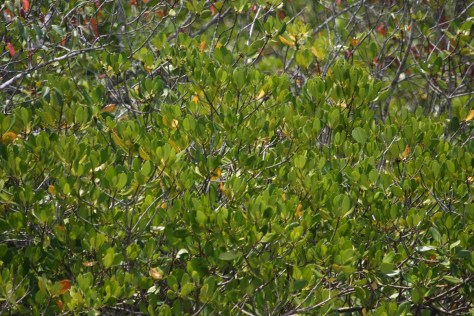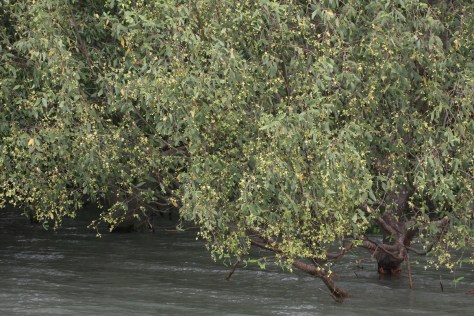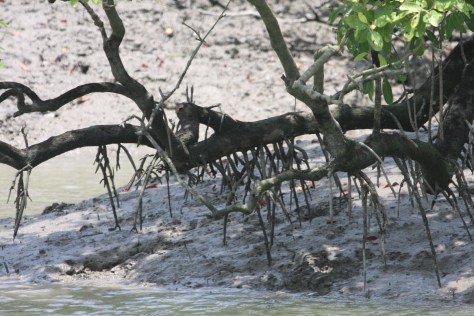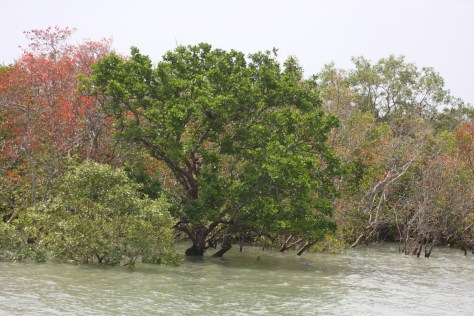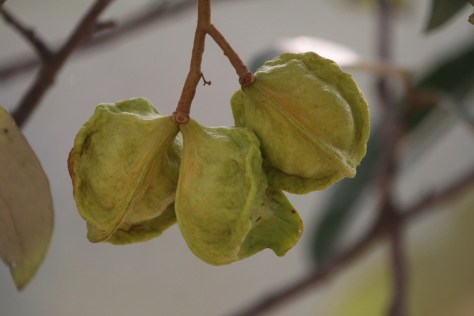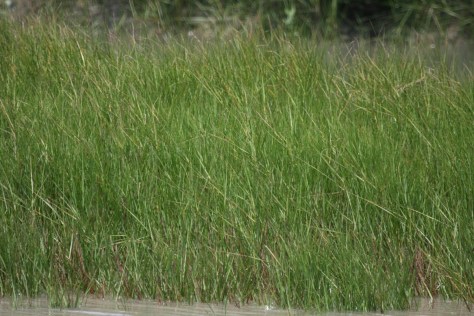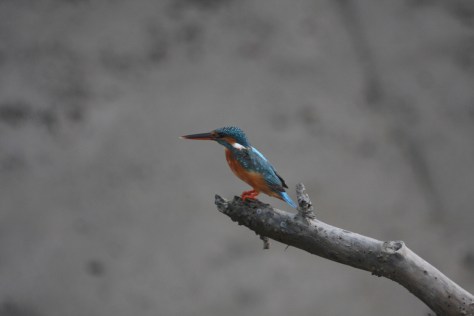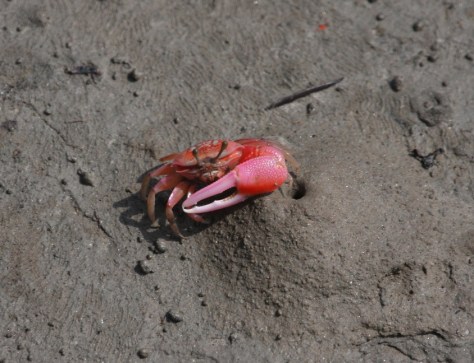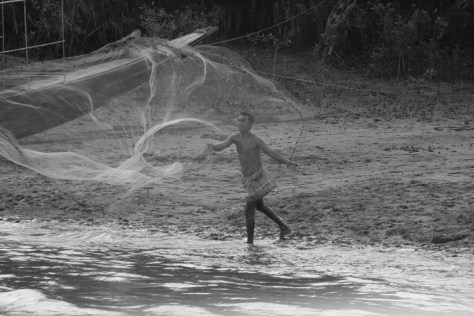Trip Report: Sunderbans National Park
Dates: 1-May to 3-May, 2015
Camp: Sunderban Jungle Camp on Bali Island
Who: VV and KB
Given the time that has passed, I’ll dispense with text and try to capture as much of the experience as possible via the images I can find. It is quite possible that between my patchy notes and patchier memory some errors have crept in.
I should mention that we were guided by a young and very competent naturalist called Animesh Manna who knows his stuff. Mangrove tree identification is a tricky animal for the unseasoned, and Animesh was exceptionally patient in helping us get the hang of it. He is a gifted spotter too and knows his birds.
Pictures are below the descriptions.
Flora
Avicennia marina. “Peara Bayen”. So named because the trunk is reminiscent of the guava tree’s blotchy, peeling trunk. This tree was extremely common.
Rhizophora apiculata. “Garjan”. With its distinctive stilt roots.
Garjan pods
Bruguiera gymnorrhiza. “Kankra”. With its buttress roots.
Excoecaria agallocha. “Genwa”. Red-leaved at this time of the year. The roots are snake-like with bulbs at the base. The sap is reputed to cause blindness, and the leaves when dried and powdered serve as an effective fish poison.
Ceriops decandra. “Jhamti/Jale Garan”. Rounded leaves reaching up; broom-like roots. Ceriops tagal – “Math/Jat Garan” has buttressed roots I believe (although my notes describe them as dome shaped for some reason).
Suaeda maritima. “Giriya Sak”. A shrub.
Spiky roots of Kaura/Keora. Sonneratia spp.
Sonneratia apetala flowers.
Pneumatophores reach out for air to compensate for the anoxic mud beneath
Aerial roots of Avicennia alba. There are three species commonly seen. Avicennia alba, A. marina and A. officinalis. Of these, only A. alba has aerial roots.
“Dhundul”, Xylocarpus granatum
Fruit of Dhundul
Tiger palm. Phoenix palludosa. “Hental/Bogra”. Fairly plentiful.
Nypa fruticans. The Nypa palm. “Golpata”. Having seen pictures of large barges laboring under tons of fronds, it came as a surprise that this palm was sparingly seen. Turns out the large clusters are evidently all on the Bangladesh side.
Fruit of Heritiera fomes. The “Sundari”. The tree for which the place is named. Another big surprise. Much of this occurs on the Bangladesh side. The few isolated specimens seen along the banks were slender and sickly looking.
Aegiceras corniculatum. “Khalsi/Kholsi”. Typically seen leaning over the water’s edge. Bulk of the nectar that goes into making the famed honey that the Sunderbans produces is drawn from the flower of this tree.
Porteresia coarctata. “Dhani ghas”, Mangrove grass or Paddy grass.
Imperata cylindrical. Spear grass. I hope the identification was accurate.
Fauna
There was reasonable variety of avifauna. Collared kingfishers were commonly met with and their calls heard even more frequently. We saw the brown-winged kingfisher a few times. We heard the calls of the Mangrove pitta at the Sajnekhali watchtower many times, but didn’t catch sight of the bird. We thought we heard the Mangrove whistler once, but certainly did not see one. We also saw orange-breasted green pigeons at the same watchtower. The Pacific golden plover, Whimbrel and the Changeable hawk eagle (dark morph) were three other candidates on our list that we did get to see.
We were aware that chances of seeing either a tiger or a fishing cat were slim. Or the King cobra for that matter. We did want to see salties and saw just one individual. It would have been nice to see one of the dolphin species, but they are not easy to come by.
Large egret patrolling the shallows
Lesser adjutant stork.
Whimbrel takes flight.
Common kingfisher
Red fiddler crabs
Water monitors. We were eager to sight these creatures after reading about 9-foot long individuals gracing the place.
Salty! Poor shot of an Estuarine croc lying inert in the shade. These reptiles have the horrendous reputation of savaging people shrimping or crabbing in the shallows.
Mudskipper.
Others
This is the standard configuration of tourist boats in the Sunderbans. A viewing deck on top; Beds, toilet and a galley below. The structure perched at the stern is an additional loo, for the crew presumably.
The Sajnekhali watchtower, where so many spectacular sightings happen. We heard a tiger call while there, but saw nothing.
The canopy walk around the Dobanki watchtower, surrounded by a sea of Avicennia marina in the main.
A little shrine to Bon Bibi, the goddess of Sunderbans legend. Honey and crab collectors fervently believe in her promise to protect anyone who steps into her realm unarmed and pure-of-heart. A necessary reassurance in a land where you take your life in your hands each time you step into the forest.
The riversides along forest stretches that lie across habited areas are strung with rather flimsy-looking nylon nets, ostensibly to prevent tigers from swimming across. Apart from the tiger and the saltie, Black-tipped sharks are a danger to people in shallow waters – they evidently sneak up and bite a chunk of flesh off the calves, leaving the person bleeding dangerously before medical help can be reached.
Tiger crossover, sometime that morning. We found the spoor on both banks and waited awhile in vain.
Ship laden with flyash crossing the vast Panchmukhani confluence, headed for Khulna in Bangladesh
So that’s what a Patton tank looks like. Someone has a sense of humor.
Birds
- Adjutant stork
- Ashy woodswallow
- Black bittern
- Black-headed cuckooshrike
- Black-hooded oriole
- Black-naped monarch
- Brahminy kite
- Bronzed drongo
- Brown shrike
- Brown-winged kingfisher
- Changeable hawk eagle (dark morph)
- Chestnut-tailed starling
- Collared kingfisher
- Common iora
- Common kingfisher
- Common myna
- Common sandpiper
- Eurasian collared dove
- Fulvous-breasted woodpecker
- Greater coucal
- Large cuckoo-shrike
- Large egret
- Lesser flameback (calls)
- Lesser whistling duck
- Lesser yellow-nape
- Little cormorant
- Little egret
- Loten’s sunbird
- Magpie robin
- Mangrove pitta (calls)
- Orange-breasted green pigeon
- Oriental honey buzzard
- Oriental white-eye
- Pacific golden plover
- Pied kingfisher
- Pied myna
- Pin-striped tit babbler (calls)
- Pond heron
- Purple-rumped sunbird
- Red junglefowl
- Red-whiskered bulbul
- Rose-ringed parakeet
- Scarlet-backed flowerpecker
- Short-toed snake eagle
- Small minivet
- Spotted dove
- Spotted owlet (calls)
- Stork-billed kingfisher
- Streak-throated woodpecker
- Tailorbird
- Whimbrel
- White-breasted waterhen
- White-throated kingfisher
Mammals
- Chital
- Rhesus macaque
- Wild boar
Reptiles
- Checkered keelback
- Estuarine crocodile
- Water monitor

